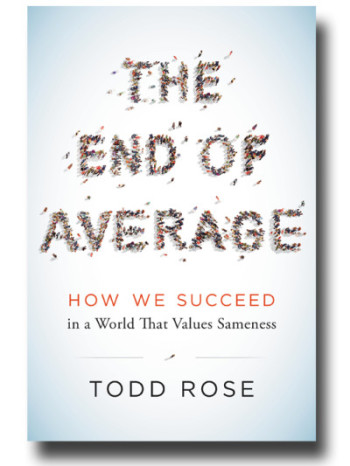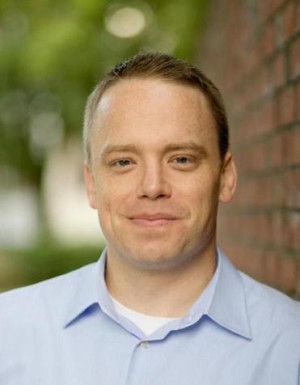 You might be tempted to say that Todd Rose isn’t your “average” high school dropout. He is, after all, currently on the faculty at the Harvard Graduate School of Education. But Rose is also author of a new book that explains why you shouldn’t refer to him, yourself or anyone around you as “average.” In “The End of Average,” Rose argues that the longstanding practice of drawing conclusions about individuals using statistical averages is flawed and damaging, especially in education. There is no such thing as an average student, according to Rose. Yet our schools, tied to one-dimensional assessments, scripted curriculum and other constraints, operate on a premise that often ignores the complexity and potential of individual students. Rose recently spoke with NEA Today about the impact “averagerianism” has had on our schools and how making more room for individuality in the classroom will strengthen relationships between educators and students.
You might be tempted to say that Todd Rose isn’t your “average” high school dropout. He is, after all, currently on the faculty at the Harvard Graduate School of Education. But Rose is also author of a new book that explains why you shouldn’t refer to him, yourself or anyone around you as “average.” In “The End of Average,” Rose argues that the longstanding practice of drawing conclusions about individuals using statistical averages is flawed and damaging, especially in education. There is no such thing as an average student, according to Rose. Yet our schools, tied to one-dimensional assessments, scripted curriculum and other constraints, operate on a premise that often ignores the complexity and potential of individual students. Rose recently spoke with NEA Today about the impact “averagerianism” has had on our schools and how making more room for individuality in the classroom will strengthen relationships between educators and students.
Why have we been so addicted to averages?
Todd Rose: There are a couple of reasons. One, it’s perceived simplicity. If you could really understand a student’s potential in one-dimensional terms, like a test score, we should do that! It’s way easier, but it’s just not true.
Also, averages are really useful in understanding groups, even today. But over time averages went from being a useful but fictional way of thinking about society to being the fundamental way to think about who you are. We’ve been living with the legacy of that ever since.
It’s a little bit of speculation, but it’s not hard to imagine that it also taps into something pretty fundamental about our competitiveness, about us wanting to be better. But what’s interesting to me is quite often science is used to work against our biases. It shows us that the world isn’t quite what we thought it was. But when we doubled down on averages and rank, it was really to confirm our biases. It was to codify them and give them this idea of mathematical truth.
It’s paradoxical that this country likes to promote an individualistic credo but has for so long evaluated individuals as they relate to a group.
TR: It’s crazy, right? It is completely paradoxical. My first question in writing the book was ” Where did this come from?” The ideas came from Europe in the mid-19th century – England and Belgium, specifically – but they were academic ideas. The United States, whether it was Frederick Winslow Taylor and scientific management or Edward Thorndike and the standardization of education, took a philosophical concept and transformed it into scientific way to rank people.
So everything about the education system is structured around average and rank - from the physical design of a classroom to the way a curriculum is structured to the way we assess students. It’s all naturally built this way because that’s how we think about things. But the system shouldn’t be about constantly comparing you to other people.
So what would an education system that moves away from focusing on averages look like?
TR: At the end of the day, it’s about having more flexibility in design so we’re not just locking kids out because of their individuality unnecessarily. When schools aren’t responsive to them as individuals, the students don’t know who they are and the teacher has the wrong lens to think about the kids and we’re all constrained by these narrow metrics of success.
We need to be more competency-based. I don’t care how you compare with the student next to you. I want to know whether you are mastering the things you need to master. Grades, for example, are too one-dimensional. You cannot collapse what a student knows or is capable of knowing or doing into a letter.
 Many people tend to confuse standards and standardization. It’s good to have common standards even in a more personalized learning environment, but how we measure them has to responsive to individuality. There are a lot of good efforts in portfolio-based assessments that provide a better way than standardized tests in understanding what kids are capable of doing.
Many people tend to confuse standards and standardization. It’s good to have common standards even in a more personalized learning environment, but how we measure them has to responsive to individuality. There are a lot of good efforts in portfolio-based assessments that provide a better way than standardized tests in understanding what kids are capable of doing.
You describe in the book how people like Benjamin Bloom believed decades ago that the static pace of classrooms, for example, wasn’t necessarily serving all students well. But the time wasn’t right to change the system. What’s in place now that makes the climate more suitable?
TR: I think now we have a solid scientific foundation for thinking about individuality and building on it. Bloom had a hunch and it was a good one but the science wasn’t there at the time. We have that now.
The second piece is technology. Technology isn’t the solution, but it is a tool for flexibility and adaptability. We don’t need some brand new invention that costs a ton of money. The architecture is already in place.
Lastly, we have the economic imperative. It was hard sell in the industrial age when you had a fixed economy. You wouldn’t have been able to say “Hey, what we should be doing is figuring out what you’re good at and there’ll be a place for you in the economy.” It wouldn’t have been true. Today we have a knowledge economy, the most diverse economy in the history of the world. The truth is if you’re good at something, odds are we can find a career path for that. So we’re just in need of getting more out of people.
When you think of technology and “personalized” learning, it’s easy to conjure up a nightmarish scenario of a student alone in a room being instructed essentially through a computer. It’s a real concern – the loss of a common learning experience and face-to-face interaction with teachers and students. Will what you’re advocating put us on this slippery slope?
TR: I’m really glad you asked that question because we’re keenly aware that the second you talk about individuality, some might think of “individualism.” What I'm interested in is a system of education that meets kids where they are as individuals and has a goal of developing them to their fullest potential. The principals of individuality that I lay out in the book, almost paradoxically, show us that by really understanding individuality and supporting it, we bring that one person closer to the group. It’s freeing up more time for the high-value relationships between the teacher and the student and that student with other students. You can best facilitate those deep social interactions by having a system that understands each person as an individual and is responsive to that. So to be really clear: this is not rugged individualism. This is not a kid learning in isolation, which is a basic violation of the principles of individuality.
What are some of the trends you’re seeing that suggest the public is ready to break free from the “tyranny of the average?”
TR: I do think people generally accept the idea that the goal is no longer to “batch process,” that it’s actually to develop and nurture individual kids. I’m encouraged by the number of components that are being developed that can actually accomplish that.
 Todd Rose, author of "The End of Average"
Todd Rose, author of "The End of Average"
A terrific trend is the shift toward a whole child perspective and seeing kids in more multi-dimensional terms. I do wish that was also extended to how we think about teachers, because we tend to measure their performance in a narrow and one-dimensional way.
So I think there is a move away from standardized design and toward a little more flexibility. It’s not like we’re trying to introduce a foreign concept to people. It’s really about reminding them of who we think we are supposed to be and what we’re supposed to believe in and just trying to make sure our institutions live up to that.
What’s your take on the new ESEA law, the Every Student Succeeds Act, and how it contributes to this potential shift?
TR: I think it’ s a step in the right direction. I tend to be a little leery that policy can actually drive innovation, but the intention is right and it’s certainly better than where we were before. My bet is we change how the public views themselves and other people. That’s critical because whenever we’ve tried education reform or transformation it always snaps back to these average-based systems, because it’s consistent with the public mindset. But I do think the component pieces are being put in place, so it’s a good time to care about these ideas.
I know your time in high school was rough. But looking back, are you able to recall some experiences that made you think, “Ok, if there was more of that, maybe the system would have worked better for me”?
TR: First of all, I’m the first to say that I contributed far more than my share to the problem. I would not want to have taught me. But the things that went well for me always came down to having a teacher who understood me. It’s a big ask when the system doesn’t support that, right? But when I was failing out of high school, I talked my way into a AP European History class, where I got an A minus. I had a teacher who really cared about knowing me and thought about the things I was interested in. It was just a good fit between us. It was the same later in college. They sensed I was capable of something and, within reason, were going to help figure out how to get that out of me. And I’ll be forever grateful for that. It helps enormously when teachers assume you’re going to succeed. That may seem so simplistic, but it's everything. So what I want to accomplish is to figure out how we create systems that support these great teachers in doing that for every student.






